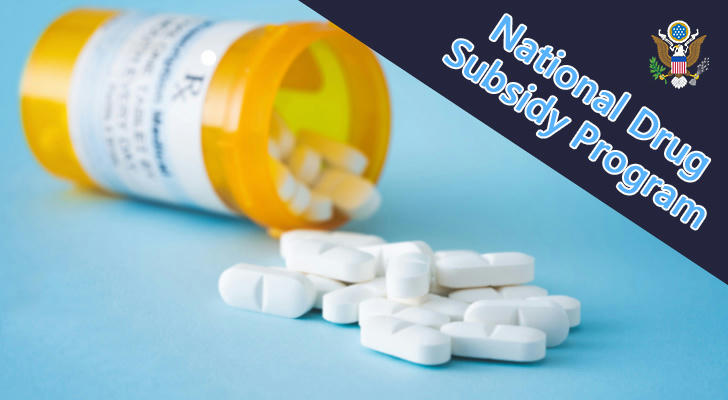📢 Major Benefit Alert! Prescription Assistance Programs Make Healthcare More Affordable – Learn How to Apply!
Introduction: High Medication Costs? Help Is Available!
For many individuals and families, the cost of prescription medications can be a major burden. With prices rising every year, affording essential medications has become a struggle for millions. However, there is good news! Prescription assistance programs are available to help reduce medication costs for those who qualify. These programs, offered by government agencies, pharmaceutical companies, and nonprofit organizations, provide financial relief and ensure that people can access the treatments they need without excessive financial strain.

1. What Are Prescription Assistance Programs?
Prescription assistance programs (PAPs) are designed to help individuals who have difficulty affording their medications. These programs vary in terms of eligibility, coverage, and benefits, but they all share the same goal: making essential medicines more accessible. Some programs offer significant cost reductions, while others provide financial support to lower out-of-pocket expenses.
There are three main types of prescription assistance programs:
Government-funded programs – These include Medicare, Medicaid, and state-run assistance programs that offer subsidies or discounts based on income level.
Pharmaceutical company programs – Many drug manufacturers have patient assistance programs (PAPs) that provide cost savings for eligible individuals.
Nonprofit and community programs – Various charities and local organizations offer prescription assistance, often helping to cover medication expenses for specific conditions.
2. Who Qualifies for These Programs?
The good news is that many people are eligible for prescription assistance, even if they don’t realize it. While requirements vary depending on the program, common eligibility factors include:
✅ Income level – Many programs are designed for individuals and families with low to moderate incomes.
✅ Insurance status – Some programs support uninsured individuals, while others assist those with insurance but high out-of-pocket costs.
✅ Medical necessity – Certain assistance programs focus on specific chronic conditions, such as diabetes, asthma, or heart disease.
✅ Age and residency – Some government programs may have age restrictions (such as Medicare for seniors) or require proof of residency in a specific state.
Checking eligibility is often quick and easy, with many programs offering online screening tools to determine qualification.
3. How to Apply for Prescription Assistance
Applying for prescription assistance is a straightforward process, but it’s essential to follow the correct steps to ensure approval. Here’s how to get started:
Step 1: Identify the Right Program
Research available assistance programs based on your needs. Websites such as [NeedyMeds] and [RxAssist] provide databases of programs that can help you find the best fit.
Step 2: Gather Required Documents
Most programs require proof of income, insurance status, and a doctor’s prescription. Be prepared to provide recent tax returns, pay stubs, and any relevant medical documentation.
Step 3: Complete the Application
Many programs offer online applications, while others require printed forms. Carefully follow the instructions and provide accurate information to avoid delays.
Step 4: Submit and Follow Up
After submitting your application, be sure to follow up with the program’s support team if you don’t receive a response within the expected timeframe. Some programs may request additional documentation before approval.
4. Popular Prescription Assistance Programs to Consider
If you’re looking for financial relief on prescription medications, here are some widely recognized programs:
💊 Medicare Part D Extra Help – A federal program that assists low-income seniors and disabled individuals in managing medication expenses.
💊 GoodRx – A discount card program that provides significant savings on prescription drugs at pharmacies nationwide.
💊 NeedyMeds – A nonprofit that connects individuals with PAPs, discount cards, and reduced-cost medical clinics.
💊 Partnership for Prescription Assistance (PPA) – Helps patients find pharmaceutical company programs that offer reduced-cost medications.
💊 State Pharmaceutical Assistance Programs (SPAPs) – Some states provide additional support for residents who need help covering medication costs.
5. The Long-Term Benefits of Prescription Assistance
Taking advantage of these programs not only provides immediate financial relief but also helps individuals maintain their health without interruptions in treatment. Many people who struggle with medication costs often skip doses or delay refills, leading to worsened health conditions and higher medical expenses in the future. By applying for assistance, individuals can:
✅ Save hundreds or even thousands of dollars per year on medication costs
✅ Stay consistent with treatment plans for chronic conditions
✅ Reduce stress and financial burden on their families
✅ Improve overall health and well-being
Conclusion: Get the Help You Deserve!
No one should have to choose between their health and financial stability. Prescription assistance programs provide a vital solution for those struggling to afford their medications. With numerous options available, finding the right program and applying for support can make a significant difference in improving both health and quality of life.
Take the first step today—explore available prescription assistance programs and see if you qualify. Relief is just an application away! 🚀
